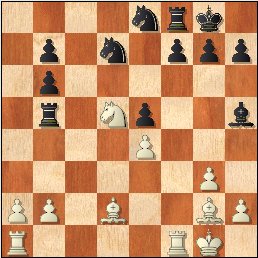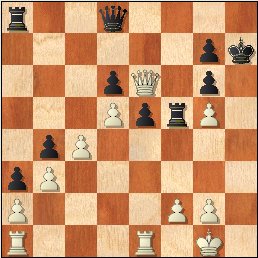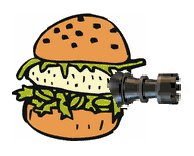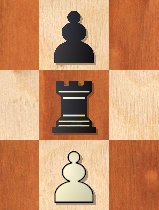

#1. After 19...Rc5x(N)b5
White to Move. What would you play? Why?
White to Move. What would you play? Why?
| Check my new site www.chessIK.com - daily puzzles that will help you improve! |
Improve your Chess via Active Learning
ACTIVE LEARNING is any strategy that involves students in doing things and thinking about the things they are doing (*)
You could study the following material either by skipping the test and going directly to the lecture. Or start by attempting to figure out on your own what is going on in each of the positions I will be talking about and then proceed to the lecture. If you chose the latter, spend time on each diagram and record your evaluation and move / plan for the side whose turn it is and sample variations. Then compare your ideas with mine. Let me know how you like the test and the lecture
Test yourself:
Level - beginner through advanced.
1. Check whose move it is / Read the question.
2. Evaluate position (i.e. White is Better, or Black is Winning, or Equal...)
3. Find the Best move and, if necessary, support it with variations. <<CALCULATE thoroughly!!>>
4. Answer the question (if there is a specific one)
 |
 |
|
#1. After 19...Rc5x(N)b5 White to Move. What would you play? Why? |
#2. After 29...Rf8-f5 White to Move. What would you play? Why? |
STOP - Lecture begins below.
"Sandwiched!" .
 |
The R is a very powerful piece. Like
other pieces, it needs space to show its strength and stay out of
trouble. The best is to keep the R on an open file and/or an open rank.
When the R leaves the back rank in the middlegame, there is always a
chance it will get stuck somewhere. One particular setup very troubling
for the R is when it is stuck between the two Ps, or, as I like to call
it - sandwiched.
See the picture on the right - its own P cuts R's path back; an opponent's P (which is presumably defended) cuts the way forward, and takes away 2 more squares along the rank. Hence, at the most, the R is left with only 5 squares. With many Ps and pieces still on the board, these squares may not be available either. |
 |
Recently, I saw two basic examples that clearly present this pattern:
|
|
#1. Almasi,Z (2717) - Robson,R (2562)
(Hungary, 2010) After 19...Rc5x(N)b5 Over the last couples of moves both players exchanged some very heavy tactical blows. Finally, Black captured the N on b5, regaining the piece. Unfortunately, his R is about to get sandwiched. 20.Ne7+! (20.Pb4+-) Kh8 21.Pb4!+- White could have played this move right away, but decided to make a check first. He expects to win the b5-R and avoids a possible ...Rxd5. Black resigned after 21...Nd6 22.a4 Re8 23.Nf5 Nc4 24.Bc3. He loses a R for only a P.
|
|
|
#2. Sadzikowski,D (2389)-
Dragun,K (2432) (Poland, 2011) After 29...Rf8-f5 Black is down a P and wanted to win the g5-P. However, he got immediately in trouble due to a weak K and a very poor placement of his pieces. After 30.Re3 (threatening 31.Rh3#) Rxg5, Black was prepared to meet 31.Rh3+ with ...Rh5. But, White played 31.Pg4!, and the Black R is sandwiched on g5. This time around, the trapped R is safe, but the culprit of the problem is its inability to defend the K. Black resigned as he can't stop Rh3+, without giving up his R. White shouldn't start with 30.Pg4 due to 30...Qxg5, with unclear position. Unlike a R, the Q can't easily be sandwiched by 2 Ps. |
==============================================================================================
Summary:
The R is a powerful piece, but keep an eye on its mobility. When the space is limited, the R can get trapped or 'sandwiched'. I hope that you found my examples instructive and entertaining. Memorizing more patterns will help you to calculate easier and should improve your results.
==============================================================================================
What do you think about this article? How did you do? For comments,
corrections send email or use
this
form
More on chess training (serious and enlightening) in my books:
|
Special offer:
Chess
Exam package: Great Present - Chess Exam and Chess Exam Tactics,
Autographed and Personalized (when requested), 2011 Chess
Cartoon Calendar ($8) + Free Shipping via Insured Media Mail -
|
|
Special offer: Get all three Chess Exam books autographed and personalized + meet me for 30 min of one-on-one Phone and/or Skype and/or ICC training session for $95 ($125 value), non-US - please add another $35 for shipping with insurance. |
|
|
Chess Exam and Training Guide (2004) |
Copyrighted @ 2011 Igor Khmelnitsky
For comments or permission to reprint please send inquires via email or this form
(*Bonwell, C., & Eison, J. (1991). Active learning: Creating excitement in the classroom (ASHE-ERIC Higher Education Report No. 1). Washington, DC: George Washington University, p. 2)